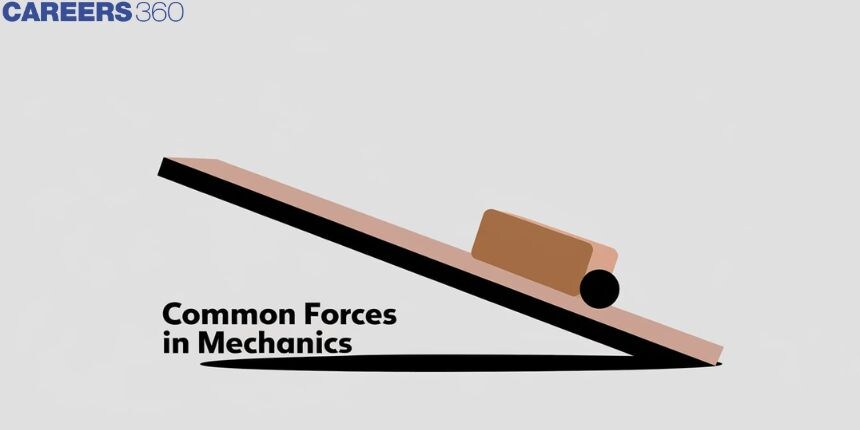Common Forces In Mechanics
Mechanics have some knowledge concerning forces if they are able to describe how objects move and interact. In a simple definition, a force is a push or pull that holds the potential of making an object to be in motion, stop or even change the direction of its motion. The following are a few of the common types of forces; gravity, friction, tension, and normal force.
This Story also Contains
- Gravitational force (Weight)
- Normal Reaction(N)
- Tension(T)
- Solved Example Based On Common Forces In Mechanics
- Summary

In this article, we will cover the concept of Common Forces In Mechanics. This concept we study in the chapter on laws of motion which is a crucial chapter in Class 11 physics. It is not only essential for board exams but also for competitive exams like the Joint Entrance Examination (JEE Main), National Eligibility Entrance Test (NEET), and other entrance exams such as SRMJEE, BITSAT, WBJEE, VITEEE and more. Over the last ten years of the JEE Main exam (from 2013 to 2023), a total of five questions have been asked on this concept.
Gravitational force (Weight)
Definition- Force with which the earth attracts an object. It always acts towards the centre of the earth. It is denoted by W=mg, where m=mass of the body and g= acceleration due to gravity.

Normal Reaction(N)
Definition- A contact force between two bodies in physical contact which acts perpendicular to a common surface in contact. A normal reaction is always a push force
Examples of Normal reactions acting on a block kept on the horizontal surface and inclined plane are shown in the figures below-


Examples of Normal reactions acting on a rod resting between the ground and wall are shown in the figures below-
Tension(T)
Tension: Force exerted by a taut string, rope or chain against pulling force along the length. It acts away from the point of contact. It is always a pull force
Tension remains the same as long as the string is the same only in the case of a massless string.
Spring Force
Spring force is a type of restoring force which tries to come back to its natural length.
F=-K x
where k is the spring constant and its unit is N/m and x is net elongation or compression in the spring.
Here -ve sign represents the restoring nature of the spring force.
Recommended Topic Video
Solved Example Based On Common Forces In Mechanics
Example 1:An object resting on a table, shown in the figure below. The mass of the object is 1 kg. Acceleration due to gravity is 9.8ms2. Determine the normal force (in N) exerted on the object by the table.

1) 9.8
2) 11
3) 4.5
4) 5.6
Solution:
$\\ \text{FBD of block-}$

Here,
N= Normal reaction force, weight, (W)=mg
Since, the body is at rest, so the net force in the y-direction will be zero
So ,N=W⇒N=mg=1×9.8=9.8N
Hence, the answer is option (1).
Example 2: Calculate the tension in the string shown in the figure. All the surfaces are frictionless. Both the blocks have a mass of 1 kg. (Take g=10 m/s2,)
1) 50
2) 5
3) 7
4) 2
Solution:
Writing the equation of motions for two blocks,
mg−T=maT=ma
Adding these two we get,
2 T=mg⟹T=0.5mg=0.5×1×10=5 N
Hence, the answer is option (2).
Example 3:
Two objects resting on a table. Mass of object 1 (m1) = 1 kg, mass of object 2 (m2) = 2 kg, Acceleration due to gravity (g) =9.8 m/s2. Determine the magnitude and direction of the normal force (R1) exerted by m2 on the m1 and the normal force (R2) exerted by the table on the m2.
1) R1=9.8 N, R2=15.4 N
2) R1=12 N, R2=17N
3) R1=9.8 N, R2=29.4 N
4) R1=10 N, R2=26 N
Solution:
FBD for m1

As there is no motion in a vertical direction, therefore the forces in the vertical direction will be equal.
So, R1=W1=m1×g=9.8 N
FBD for m2

Here R2=W2+W1=(m2×g)+W1=(2×9.8)+9.8=29.4N
Hence, the answer is option (2).
Example 4:
An Atwood machine has masses 5Kg and 15 Kg as shown
What is the acceleration (in m/s2) at 15 Kg mass when the system is released from rest

1) 5
2) 10
3) 8
4) 15
Solution:
Free body diagram of the given system:

Equation for 5 kg block :
$
T-5 g=5 a \quad-(1)
$
Equation for 15 kg block :
$
15 g-T=15 a \quad-(2)
$
Now, by adding equation (1) and (2) we get,
$
\begin{aligned}
& 10 g=20 a \\
& a=\frac{10 \times 10}{20} \\
& \therefore a=\frac{100}{20}=5 \mathrm{~m} / \mathrm{s}^2
\end{aligned}
$
10g=20aa=10×1020∴a=10020=5 m/s2
Example 5: A body of mass 1 kg lies on a smooth inclined plane. A force F=10m is applied horizontally on the block as shown. The magnitude of normal reaction by the inclined plane on the block is

1) 102 N
2) 102N
3) 10 N
4) None of these
Solution:
Free body diagram of given system

Equation of 1 kg block Perpendicular to inclined plane :
N=10sin45∘+mgcos45∘N=102+102=102N
Hence, the answer is option (1).
Summary
Consider riding a bicycle up and down a hill. On the uphill ride, you are expending one type of energy, "pedalling energy." Gravity pulls you back down the hill. As you coast down the hill, gravity helps accelerate the bike, and resistance from the wind pushes on you. understand these experiences lie the forces of mechanics. They form the foundation for comprehending the motions of things and the reason why they travel in that particular way.
This article was dedicated to give us the basic understanding and descriptions of the fundamental forces in mechanics. We have learned about the gravitational force, the universal attractive force between all objects. The resistive frictional force during sliding contact was studied.


